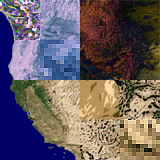|
The Digital Cultures Project, the Multi-Campus
Research Group based at UC Santa Barbara that brings together
individuals from across the UC system who are actively engaged
with the impact of the new digital technologies on humanistic
studies and the arts, recently hosted its first research fellow,
Michael Heim. Heim teaches graduate seminars on Virtual Reality
(VR) for the School of Cinema-Television at the University
of Southern California, for the Art Center College of Design
in Pasadena, and for the Science & Technology Program at California
State University - Long Beach Extension. Trained in classical
philosophy with a focus on technology, Heim spent the month
of April in residence at UC Santa Barbara researching and
conducting a number of public events aimed at sharing his
current work on VR with members of the UC Santa Barbara community.
Heim's work considers the philosophical issues
we face as we undergo the digital mutation. In Electric
Language: A Philosophical Study of Word Processing (Yale
Univ Pr; 1987; reprinted 1999), Heim discusses the impact
of word processing on our use of and ideas about language.
His next work, The Metaphysics of Virtual Reality (1993),
asks how our increasing immersion in computer-generated worlds
will alter the ways in which we perceive our world. He explores
the concepts of cyberspace, virtual reality, as well as the
effect of word-processing on the English language, and literacy
in the age of hypertext. Most recently, his book Virtual
Realism (1997) offers a comprehensive introduction to
VR and comments on its potential impact upon society. He contends
"we must balance the idealist's enthusiasm for computerized
life with the need to ground ourselves more deeply in primary
reality." This "uneasy balance" he calls virtual realism.
Heim used part of his time at UC Santa Barbara
to work on a chapter for his latest project, a book on the
aesthetics of 3-D avatar worlds on the Internet. The project
developed out of a keynote paper presented on October 24,
2000 in Seoul, Korea, for the international conference "Virtual
Reality Software Technology 2000" (VRST 2000) sponsored by
the ACM Siggraph organization. According to Heim, the paper
("The
Feng Shui of Virtual Environments," available online)
"bridges engineering with aesthetics and was presented in
an art museum in Media City, Korea. The software engineers
at VRST recognized the need to develop aesthetic principles
for future VR developments. My presentation explained four
discoveries made during productions of the online 3-D CyberForum
series from Art Center College of Design in Pasadena, California,
where I have led the virtual worlds team in designing avatar
worlds since 1997." These CyberForums consist of real-time
online chats with authors and artists in 3D avatar worlds.
While in residence, Heim conducted two of his CyberForums.
Discussing the topic "Working in Web 3-D," participants met
in ActiveWorlds with Miltos Manetas, 3-D web artist and nominee
for the 2001 World Technology Award for the Arts. For the
second CyberForum, the venue changed to Heim's self-designed
CyberPlatform, and participants met with Thomas B. Sheridan,
Professor of Engineering and Applied Psychology (Mechanical
Engineering), MIT, and founder of MIT Virtual Reality journal
Presence,
the first journal for serious investigators of teleoperators
and virtual environments. Sheridan's topic, "Descartes, Heidegger,
Gibson, and God: Toward and Eclectic Ontology of Presence,"
provided a few interesting wrinkles for those in attendance.
For participants new to the forum, the discussions were both
disorienting because of the lack of real world content, but
oddly exhilarating because of the way to bring participants
together.
Heim was exceptionally generous with his
time and conducted three other public events, as well as making
himself available to both faculty and students for informal
conversations. He began his residency with a Transcriptions
colloquium entitled "The Classic Book and Avatar Chat": A
Research Overview with Hands-On Involvement, which served
as a VR primer. He also hosted an all day workshop on designing
Virtual Reality for avatar worlds. Participants in this workshop
spent the morning exploring avatar communities in "ActiveWorlds"
and "Blaxxun." That
afternoon, Heim gave a hands-on demonstration of Spazz3-D,
a Virtual Reality Modeling Language (VRML) modeling tool that
allows users to build virtual reality universes. Finally,
and undoubtedly the highlight of his residency, Heim held
a conversation on VR organized around a joint meeting of Digitalizing
Culture, William Warner's undergraduate and graduate seminar.
The discussion concerned a number of readings, including Heim's
"VR 101" and "From Interface to Cyberspace," and William J.
Mitchell's "Architectonics." Knowing that the pieces would
produce many different frequencies in the seminar, and in
order to pick up those frequencies, Heim asked each member
of the group to contribute something, either a question on
the reading or a general concern about VR. A spirited dialogue
ensued, and a number of thoughtful questions arose from what
one might call Heim's idealism about the possibility of "spontaneous"
and "human" encounters in the VR world.
One of Heim's contributions to discussions
about VR is his commitment to developing a humane ethos for
VR; however, he does not make this project a somber one, but
playful and affirmative. He is against a slavish mimicry of
the real world, and instead advocates VR environments that
are more artistic and inventive.
|

